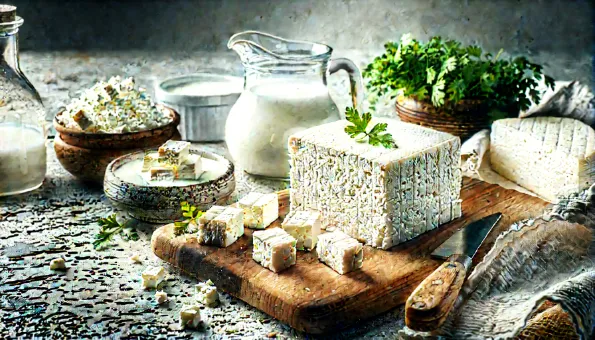Paneer: Fresh Non-Melting Indian Cheese Rich in Complete Protein & Calcium
Paneer is a fresh, acid-set, non-melting cheese supplying ~14–18 g complete protein and ~250–300 mg calcium per 100 g—versatile for curries, grills & high-protein vegetarian meals.

What Is Paneer?
Paneer is a **fresh, unaged, acid-set cheese** made by heating cow or buffalo milk and coagulating with food acid (lemon juice, vinegar, citric acid). The curds are drained and pressed into a cohesive block that **does not melt** when heated, allowing it to fry, grill or simmer without losing shape.
Nutrition (per 100 g typical paneer)
| | Amount | Notes |
|---|---|---|
| Calories | 260–300 kcal | Depends on milk fat |
| **Protein** | 14–18 g | High-quality (casein + whey remnants) |
| **Fat** | 20–24 g | Mostly saturated + some MUFA |
| **Carbohydrate** | 2–3 g | Low lactose (some drained) |
| **Calcium** | 250–300 mg | ~25–30% DV |
| **Phosphorus** | 200–250 mg | Bone mineral synergy |
| Sodium | Low (if unsalted) | Salt added post-press if desired |
Contains B12 (dairy), riboflavin, small amounts of vitamin A (retinol).
Potential Benefits
- **Complete protein** supports muscle maintenance & satiety in vegetarian diets.
- **Calcium + phosphorus** for bone and teeth health; casein slow release aids overnight recovery (e.g., paneer at dinner).
- **Low lactose** (most whey drained) → often better tolerated than milk for mildly lactose-sensitive individuals.
- **Non-melting texture** gives meat-like bite for plant-forward meals; absorbs sauces well.
Drawbacks & Precautions
- **Energy dense & high saturated fat**; large portions raise calorie & sat fat intake (choose part-skim versions to reduce).
- **Not vegan** (dairy); potential allergen (milk proteins, casein & whey) and unsuitable for dairy-allergic or strict lactose-intolerant individuals.
- **Commercial salted/fried preparations** can be high in sodium or added oils.
- Overcooking → tough, rubbery texture; needs gentle heating after searing.
Culinary Uses
- **Curries:** Palak paneer (spinach), matar paneer (peas), paneer tikka masala.
- **Grilled / Tikka:** Marinate cubes in yogurt + spices, skewer & grill.
- **Scrambled (bhurji):** Crumble into spiced onion-tomato base as protein filling.
- **Stuffings:** Use grated paneer in parathas, samosas or vegetable rols.
- **Salads & Bowls:** Lightly sear cubes for chewy protein addition.
Homemade Technique
1. Heat milk (preferably whole) just to a gentle boil.
2. Stir in diluted acid (e.g., 2–3 Tbsp lemon juice per 2 L) until curds separate & whey turns translucent yellow-green.
3. Strain through muslin; rinse lightly to remove excess acid.
4. Gather cloth, twist & press (30–60 min) with weight for desired firmness.
5. Chill before cubing for clean cuts.
Texture & Nutrition Optimization
- For **softer paneer**, press less time (15–20 min); for grilling, press longer (60+ min).
- Add **herbs or chili flakes** during curd collection for flavored paneer.
- To lower fat: start with **part-skim milk** or mix 70% whole + 30% skim.
- Retain whey (contains residual lactose, minerals) for kneading dough, soups or smoothies.
Storage
Refrigerate submerged in lightly salted water or whey **3–4 days** (change liquid daily). Freeze (wrapped) up to 2 months—thaw slowly; texture becomes slightly crumbly (good for bhurji).
Health Context & Serving Tips
- Combine paneer with **fiber-rich vegetables & legumes** (spinach, peas, chickpeas) to balance calories and improve micronutrient density.
- Portion guide: **50–70 g** (approx. 1/3–½ cup cubes) fits into many balanced meals.
- Choose **dry-roast or air-fry** instead of deep-frying to reduce added oil.
Key Takeaways
✔︎ High-quality vegetarian protein & calcium
✔︎ Non-melting texture versatile in savory dishes
✖︎ Calorie & saturated fat dense—mind portions & cooking method.
- 1. Paneer
Incidental ingredient mentioned in text

